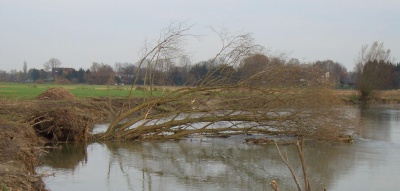Difference between revisions of "Introduce large wood"
| Line 24: | Line 24: | ||
*Biota (general and specified per Biological quality elements) | *Biota (general and specified per Biological quality elements) | ||
| − | {| class="wikitable" | + | {| class="wikitable" |
|- | |- | ||
! Macroinvertebrates !! Fish !! Macrophytes !! Phytoplankton | ! Macroinvertebrates !! Fish !! Macrophytes !! Phytoplankton | ||
|- | |- | ||
| ++ || ++ || + || o | | ++ || ++ || + || o | ||
| − | + | |}<br /> | |
'''Macroinvertebrates:''' <br /> | '''Macroinvertebrates:''' <br /> | ||
Revision as of 15:24, 25 May 2010
Contents
- 1 Introduce large wood
- 1.1 General description
- 1.2 Applicability
- 1.3 Expected effect of measure on (including literature citations):
- 1.4 Temporal and spatial response
- 1.5 Pressures that can be addressed by this measure
- 1.6 Cost-efficiency
- 1.7 Case studies where this measure has been applied
- 1.8 Useful references
- 1.9 Other relevant information
Introduce large wood
Introduce large wood06.
Objective: In-channel structure and substrate improvement
General description
Large wood is a key feature in temperate forested ecoregions. It serves as a habitat for fish and additionally as a food resource for a large number of macroinvertebrate species. Moreover, it increases flow, substrate, and habitat diversity by influencing stream hydrology, hydraulics, sediment budget, and morphology. Organic matter settles in lentic zones that develop behind large wood and is trapped by complex woody structures, increasing the availability of food for macroinvertebrates.Considering its beneficial effects on stream morphology and biota, large wood can be used for many objectives in stream restoration projects. Many such projects have focused on the active placement of artificially fixed wood structures in the stream in order to improve fish habitat. The fixation of wood structures is necessary where land use rather tightly constrains the options for stream restoration. If land-use pressure is low and downstream transport can be admitted, an artificial log jam can be installed at the downstream end of the reach in order to trap floating wood according to Gerhard and Reich (2001). Upstream from these barriers large wood can simply be placed into the stream without costly fastening it in a technical way.
Active placement leads to a short-term improvement of aquatic habitat and can be regarded as an interim measure prior to the establishment of a riparian forest providing natural input of large wood (recruitment).
Applicability
Fast or free flowing section to allow for flow- and morphodynamics, but even in impounded reaches large wood itself provides valuable habitat
Expected effect of measure on (including literature citations):
- HYMO (general and specified per HYMO element)
• Increase of flow and substrate diversity
• Increase of morphodynamics, scour and deposition, pools and bars
• Retention of organic material
- physico-chemical parameters
• Local increase of flow velocity, sediment dynamics as well as winnowing of fines, and increase of interstitial pressure gradients leading to local clean gravel.
- Biota (general and specified per Biological quality elements)
| Macroinvertebrates | Fish | Macrophytes | Phytoplankton |
|---|---|---|---|
| ++ | ++ | + | o |
Macroinvertebrates:
• Increase of macroinvertebrate species which use large wood as habitat, shelter or food, several species are closely associated with wood
• Increase of species which rely on stable substrates in sand bed streams
Fish:
• Large wood provides cover for fish and creates low-velocity zones as well as shallow areas for poor swimmers and juvenile fish.
• Increase of flow- and substrate diversity and hence, habitat diversity for fish.
Macrophytes:
• Minor positive effects on aquatic and semi-terrestrial vegetation.
Phytoplankton:
• No significant effect
Temporal and spatial response
Pressures that can be addressed by this measure
Cost-efficiency
High cost-efficiency: Comparabe high maintenance costs especially for fixed wood structures but also high ecological effect.
Case studies where this measure has been applied
- Westlicher Abzugsgraben
- Lahn Cölbe
- Stream valleys in the Arnsberger forest (LIFE project)
- Enns - Aich
- Amesbury - Demonstrating strategic restoration and management STREAM (LIFE05 NAT/UK/000143)
- Chilhampton - Demonstrating strategic restoration and management STREAM (LIFE05 NAT/UK/000143)
- Fovant - Demonstrating strategic restoration and management STREAM (LIFE05 NAT/UK/000143)
- Upper Woodford - Demonstrating strategic restoration and management STREAM (LIFE05 NAT/UK/000143)
- Woodgreen - Demonstrating strategic restoration and management STREAM (LIFE05 NAT/UK/000143)
- Hampshire Avon - Hale
- Hampshire Avon - Seven Hatches
- Lippeaue Klostermersch
- Ruhr Binnerfeld
Useful references
Gregory et al. (2003), Gerhard & Reich (2001), Kail et al. (2007)
